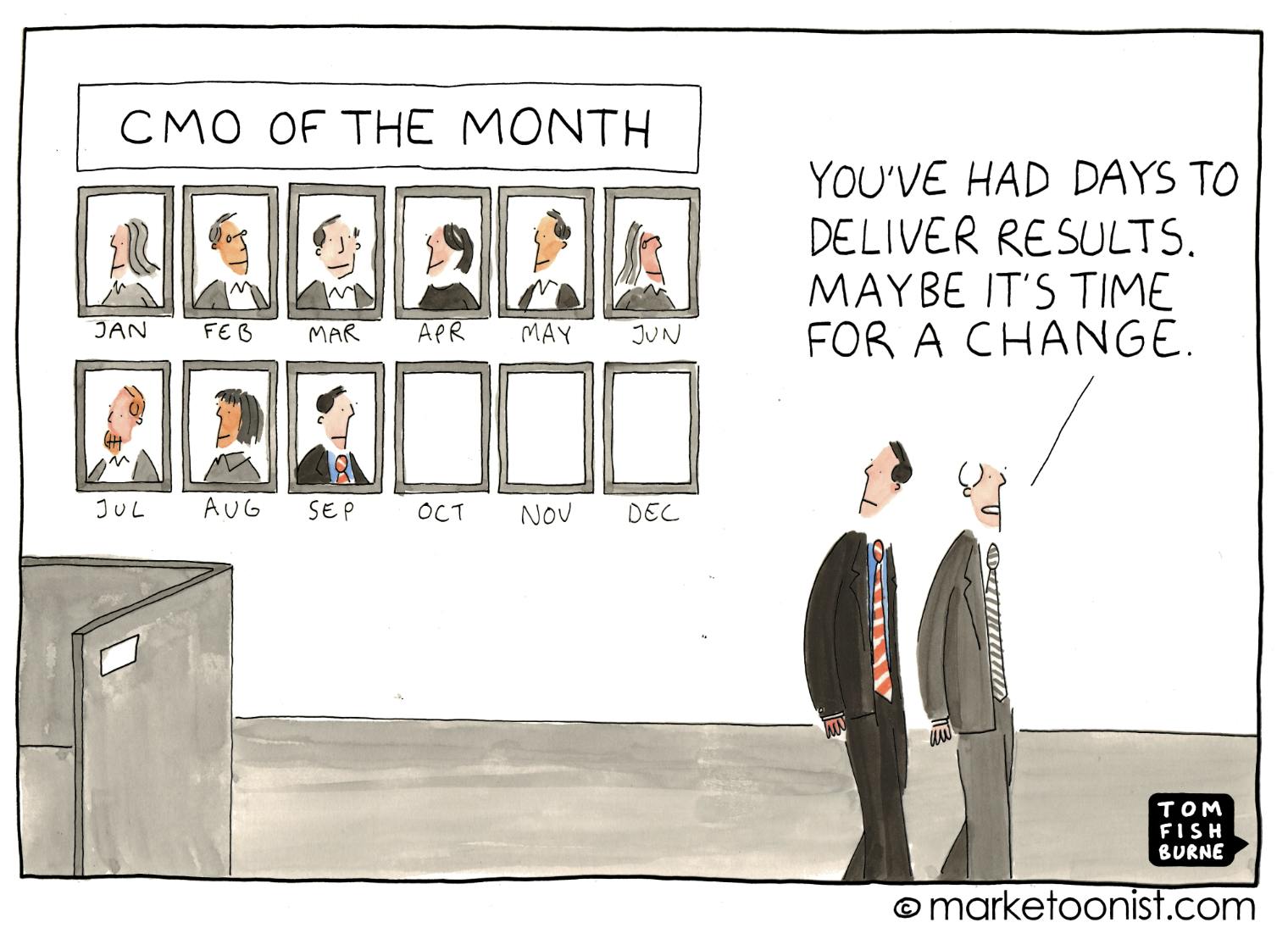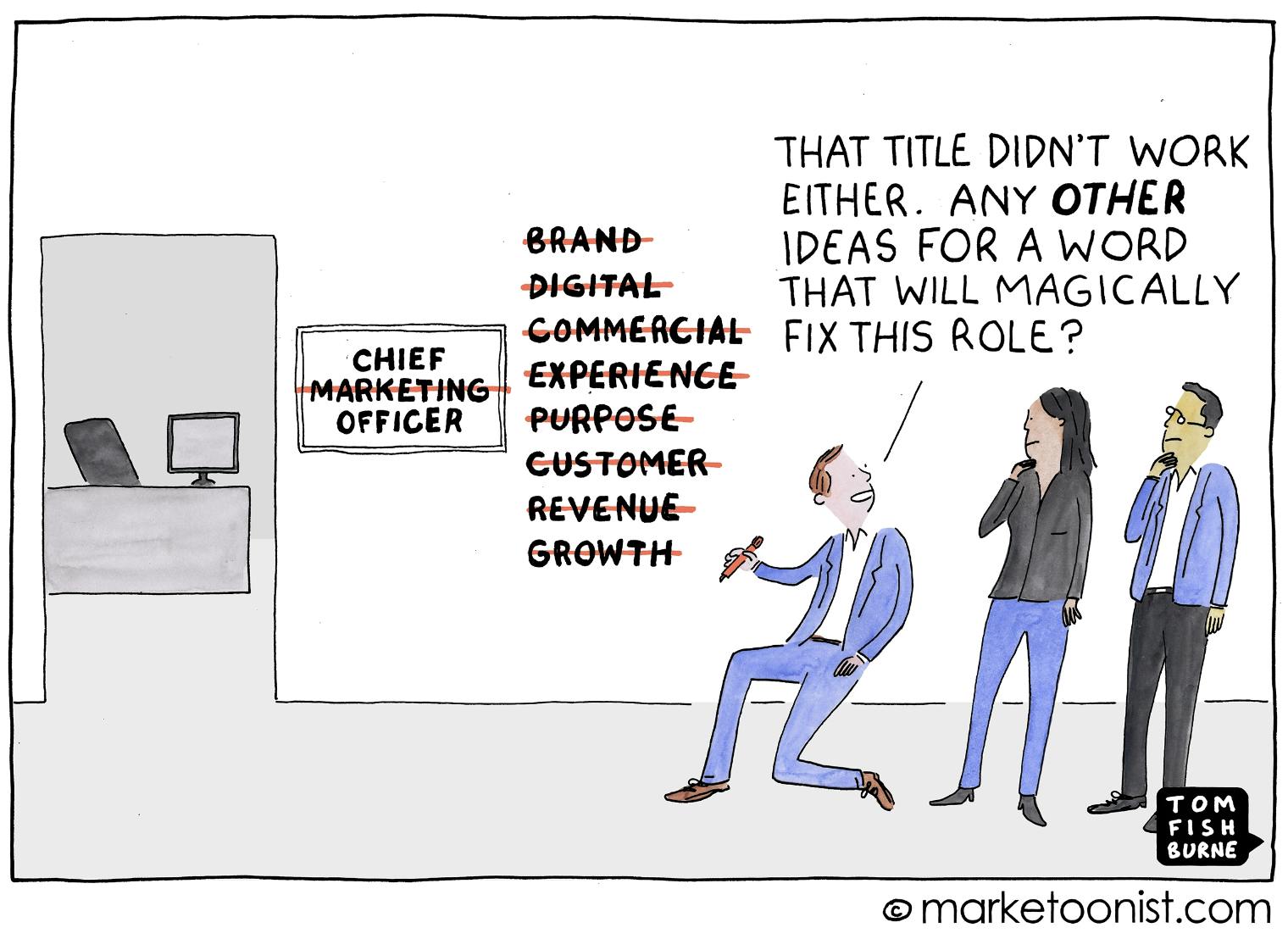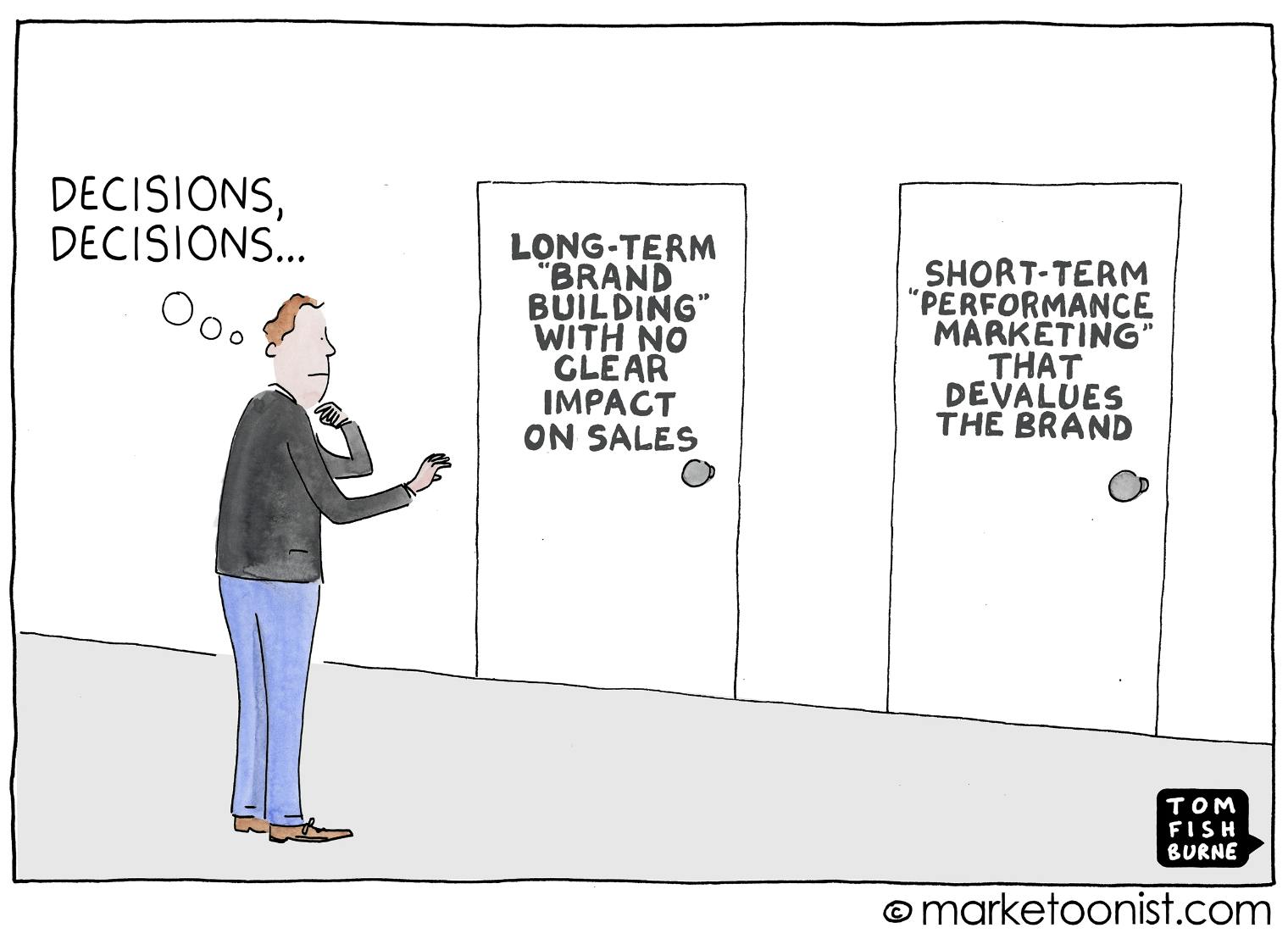A version of this article first appeared in the Forbes Communications Council, by Scott Turner, Forbes Communications Council Member and Chief Marketing Officer at BERA. Forbes Communications Council is an invitation-only community for executives in successful public relations, media strategy, and creative and advertising agencies.

In his article, “CEOs, Executive Recruiters And The Problem Of CMO Tenure”, Forbes writer Seth Matlin confirmed what we intuitively know–that the half-life of a CMO is low and is trending downward. The Wall Street Journal cited the same Spencer Stuart research indicating CMO tenure is the lowest in a decade, half as long as CEO tenure. Either America, the cradle of modern marketing, is suddenly full of untalented CMOs who are embodying the Peter Principle, or something bigger is indeed at play.
We hypothesize two reasons for this: 1) out-of-control expectations for CMOs and 2) high-stakes brand bets built on ambiguous data. The first reason sets the CMO up for failure. The second is used to confirm that the CMO’s instincts are wrong and that “we need to go in a new direction.”
High expectations of marketing outcomes
Here are some observations that might shed a bit of light on expectations from marketing leadership: CMOs are subject to wildly divergent expectations from multiple stakeholders ranging from the CEO (“what are you doing to make us the most admired brand in our industry?”), Heads of Sales (“where are my leads?”), CFO (“what is the ROI of my marketing spend?”), and frankly, everyone else (“why can’t our company do an awesome SuperBowl commercial like those other guys?”). Sound familiar?
In the WSJ article cited above, Gartner VP Analyst Chris Ross said, “In some organizations, just the expectations for CMOs are just so out of whack with the reality of what a CMO can really deliver on the timelines, and with the resources and with the headwinds that they have,” Mr. Ross said. “I think you’ve just set up to fail in some organizations, right?”
Marketing responsibilities
It doesn’t stop at expected outcomes. CMOs’ responsibilities cover far more ground than their corporate counterparts. Sales does sales. Finance handles finance. Consider though the breadth of Marketing’s original 5Ps.
Product: Marketing handles product-related activities from market research to creating Market and Product Requirement Docs (MRDs and PRDs) that create business plans for new markets to enter and the products that will win them over. And, of course, launching those products with the right buyer education and hype falls on marketing teams.
Promotion: Speaking of hype, promotions, merchandising, messaging, branding, advertising, media/PR strategy, influencer relationships, and more are central to marketing success.
Price: Similarly, pricing, discounting, seasonal sales, and licensing decisions fall on marketing.
Place: Often overlooked by non-marketers are “place” decisions, including distribution, retailing, shelf space, omnichannel experiences (buy online, pickup in-store), partner arrangements, affiliate marketing, and content syndication that deliver physical and digital products to customers’ hands and screens.
People: Whether a company spokesperson, celebrity sponsorships, or even front-line workers, the “face of the company” is an integral part of the customer experience and, thus, another key responsibility of marketers.
Each of these requires excellent recruiting, training, and retention of entire departments of talented marketing teams. Managing all of these functions would already require an extraordinary leader. But wait, there’s more! In recent years, CMOs are expected to master new responsibilities that further stretch the capabilities of mortal marketers.
CMO Identity Crisis
Matthew Banton of Burger King recently stated that “marketing is art and science.” I prefer to say that marketing is persuasion and pivot tables, but let’s not quibble. The point is that modern marketers are expected to master ever more disparate skills–spanning the far hemispheres of their brains’ left and right sides. Consider the following expectations that have recently piled onto Marketing’s original (and ambitious!) 5Ps.
CMO as Forensic Accountant: Where are our leads and pipeline coming from, and how can we lower our costs? Did consumers buy our candy bar after seeing billboards, tv spots, or grocery store endcaps? Which ones worked? Which didn’t? Did clients buy our enterprise software after seeing our webinar, digital ads, or tradeshow? And how quickly can we safely cut our most expensive lead sources? A favorite of private equity (PE) investors and CFOs, the focus here is on lead attribution, customer acquisition costs (CAC), marketing efficiency, Cost Per Lead (CPL), and return on ad spend (ROAS).
CMO as Storyteller: Wine is made of grapes. Coffee is made of coffee beans. Software is made of code. CMOs must move beyond the functional to inspire their customers with a higher purpose behind their brand. They must connect with customers by assuring them that their brand aligns with their customer’s values. Beyond the product, marketers add important narratives such as how the company takes care of its employees, vendors, customers, and even the planet with fair wages, highest quality/organic ingredients, sustainable practices, or a great origin story (“it all started here in this very garage”) for why their company even exists.
CMO as Data Scientist: Matthew Banton noted, “Don’t fall in love with an idea unless you can back it up with data.” More forward-looking than the Forensic Accountant role above, this CMO job is aimed at teasing out the metrics that matter–the hidden insights that move the needle in that big data haystack. These folks know where the hockey puck is going, not just where it is. The role satisfies board of directors (BoD) requests to become a data-driven organization.
CMO as Chief Growth Officer: CEOs and board directors are impatient, waiting for sales teams to close deals. They want marketing teams to own the pre-sales awareness, engagement, and education of prospects so that, in theory, sales teams can become order takers. They want CMOs and their teams to fill today’s sales pipeline and look out for multiple quarters and years to determine the following markets to conquer–opening new geographies, creating product line extensions, adding partner channels, or even M&A activity.
CMO as Chief Technical Officer (CTO)/Chief Innovation Officer: HubSpot’s Scott Brinker has been tracking and categorizing the bewildering 4000+ software products that aim to be part of the modern marketer’s tech stack. Today’s CMO must have a point of view about leveraging the power of the internet, big data, and AI to find and engage new prospects, route them to the right sales channel, track their progress, and build their loyalty. These have been crucial for performance and digital marketing.
CMO as Chief Customer Officer – In SaaS (software as a service) business models, customer churn is the bane of an organization’s existence. This marketer’s job does not end at customer acquisition. In many ways, it begins there. CMOs are expected to be heavily involved, if not leading the relationship marketing efforts, to ensure loyalty, renewal, share of wallet, and expansion.
So that’s it. For a CMO to survive, they simply need to become a data-driven storyteller who builds a hyper-efficient and effective tech stack enabling pipeline growth and creating customer connections that ensures ongoing loyalty. Easy right?

The challenges of the CMO do not end with their expansive responsibilities. CMOs are also under duress for another reason: they must routinely make big brand budget decisions despite massive uncertainty.
The elephant in the room: Brand vs. Performance Marketing
What gets measured gets done. Since the internet era, performance marketing and its twin, digital marketing, have become increasingly more measurable. Those impressions, clicks, opens, downloads, trials, orders, and renewals are super-trackable and quantifiable. So naturally, spending on performance marketing increased, and career-savvy marketers took heed of the advice of their mentors to “stay close to the revenue.”
Meanwhile, brand marketing was surviving without thriving. Brand-oriented advertising and creativity might win awards, but CMOs could never satisfactorily answer tough questions from their CFO or board of directors about tying their brand investment to business outcomes such as increased revenue or enterprise value.
Depending on the company, spending on brand can reach billions of dollars annually. But brand has been challenging to measure–an anachronism in the internet era. The few quantitative tools available to decision-makers include market research and brand monitoring, which both suffer from delayed timing and limited scope. The math is daunting. Multi-million dollar brand budgets often rest on the hunches of 20-somethings at brand agencies.
Even the notion of playing it safe can cost CMOs their jobs. Consider a $200 million brand campaign to gain new beer customers among men aged 25-35 based on the brand’s perceived “fun.” Sounds reasonable, but how do you know that $200 million is the right spend? How do you know that this is the right age cohort? Is “fun” the best aspect of your brand, or is it “authenticity”? Is acquiring new customers even the best course of action, or is your money better spent on aiming at more loyalty/higher share of wallet from your existing customers? Which are your most favorable geographies? You will never know from traditional market research or brand trackers. Marketing and brand leaders are set up to fail without the proper, forward-looking data to guide them.

A Two-Part Solution to the Problem of Falling CMO tenure
Our solution requires old-fashioned prioritization combined with new brand technology.
Get real
CMOs are pulled in many conflicting directions. Those assessing CMO performance should stack rank and prioritize what their brand needs. If everything is the top priority, then nothing is. From the extensive list of expectations and responsibilities called out above, CEOs and their boards should pick a major and some minors. Then hire and budget accordingly. This first part of our two-part solution is about setting priorities and focus. It requires tough decisions, including the discipline to say “no” or, at the very least, “not now.” Part one of our solution to CMO tenure is managerial, mainly in nature.
Get real data
The second part of our solution is technology-based, aimed at helping the CMO and their brand teams make truly informed decisions based on real-time customer insights. Performance and digital marketers have thousands of martech software choices to provide data-driven decisions. By contrast, CMOs needing to place important brand bets have limited scope, limited time frame for market research, high-priced consultants, and agencies to guide them. As a result, it’s time for CMOs brand teams to embrace new categories of brand-oriented martech, sometimes called predictive brand tech or performance brand building.
This technology captures an ongoing data stream of customer and non-customer brand sentiment by segment to identify hidden insights and opportunities and takes the next step by recommending optimal brand positioning. Predictive brand tech or performance brand building requires a lot of ongoing brand data, so choose your brand tech stack wisely. It’s nearly impossible to imagine performance marketers not analyzing their digital marketing spend results.
Similarly, the stakes are too high for CMOs’ careers and for the health of their brands to continue business as usual. By demystifying their previously ambiguous brand bets, CMOs and their brand teams can benefit from data-driven decisions based on metrics that matter and that directly tie to business and financial results like lifts in revenue and enterprise value. This will go a long way toward satisfying the CEOs, CFOs, heads of sales, and Boards who ultimately determine CMO tenure.




